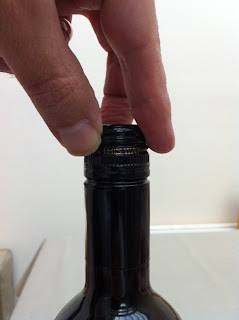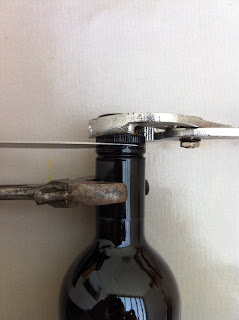There has been a lot of claim and counter-claim about corks vs screwcaps. But what no-one seems to have addressed is the aesthetics of their removal.
You may think this is ridiculous. The whole idea of a screwcap is the ease of removing it. Sadly, for someone like me, ease is an alien concept. Effort equals reward. And style is all.
Removing a cork can be an act of elegance and flair. It is a beautiful thing to see a capsule cut and a cork professionally pulled, with little flourishes and smooth, effortless grace concluding with a gentle pop. It is a skill some of us struggle, over years of practice, to master.
And a skill some never learn. I am reminded of CJ’s wrestling match with a cork, when “the cork started to split, and by the time I’d dragged the thing out into the open (like pulling a sack of sand across a ploughed field) there was cork everywhere, over the table, an acne of cork bits floating in my bell-shaped glass.” CJ has always expressed a preference for the screwcap. This does not surprise.
So is there a manner of removing a screwcap which even begins to echo the grace and elegance of a skilful cork removal? Let us consider the methods:
So is there a manner of removing a screwcap which even begins to echo the grace and elegance of a skilful cork removal? Let us consider the methods:
1) Making a fist of it. Effective, but brutal and ugly. If statistics are correct, 99% of men will be familiar with this grip (and the other 1% are lying). Both activities can be enhanced, I understand, by a flamboyant twist of the wrist at la moment critique. Nevertheless, both are but crude and less satisfying imitations of superior activities.
2) The inverse fist – more polite (because less onanistic), but clumsy and awkward to the opener themselves. It often fails to provide sufficient grip to separate cap from sleeve. See 5).
3) The flick. The ne plus ultra of screwcap removal. The cap is snapped free with a sharp movement of second finger and thumb, the same as a click of the fingers. I was once greatly impressed by an usher separating tickets from their stubs like this. The only cool way to remove a screwcap, but demanding immense finger strength.
3a) The inverse flick. Given the direction of the screw thread, this is only for the left-handed, but could be even more challenging than finding left-handed corkscrews.
4) The optimist. The cap is held delicately but firmly betwixt first and second fingers and thumb and, as with opening champagne, the bottle is rotated and the cap held still. Called the optimist because it assumes that the cap will simply and cleanly, with only a little effort, separate from its sleeve. It will probably not. Once again, see 5).
5) The tools. Am I alone in finding that a troubling number of screwcaps simply refuse to open? What I think of as Thatcher caps – simply not for turning. Or, worse still, the cap clings to the sleeve, the sleeve fails to cling to the glass, and the whole thing simply revolves around the bottle neck. Unlike the single, efficient corkscrew, you may then require any of three tools to get the thing open; monkey wrench to hold the sleeve, pliers to grasp the cap, and a knife to sever those irritating little stubs of metal which hold the cap to the sleeve. (The knife will almost certainly be blunted and ruined. It may also slip, and cut one’s left thumb, in that fleshy bit on the side just below the nail. Trust me.)
And then there’s the sound. I was taught that a champagne cork should be removed, not with a vulgar explosion, but with a gentle pfft, described to me as the sound of a duchess farting. There must be a similar analogy for the lovely sound that accompanies the removal of a standard cork – suggestions welcome in Comments. That resonant, optimistic pop of a cork being pulled, as anticipative as the tap of a conductor’s baton, can never be replaced by the harsh clack of a screwcap being removed.
Nothing, of course, can alter that clack sound, with all its nasty connotations. You can only smother it, with a well-timed cough or stamp of the foot. This technique is judiciously accompanied for some with an appropriately-placed Tena pad.
So, you have succeeded. What to do with the cap? You need not sniff it. Experts have long argued the value of being presented with a cork to sniff; no-one has ever suggested the benefits of sniffing a screwcap. (Which is just as well, because another thing in favour of corks is that you never run the risk of lacerating your nose on any aforementioned little stubs of metal.)
A screwcap does not look nice on the table next to the decanter. It does not tell you the vintage. It is rarely a souvenir. There is nothing you can do with it other than throw it away.
3) The flick. The ne plus ultra of screwcap removal. The cap is snapped free with a sharp movement of second finger and thumb, the same as a click of the fingers. I was once greatly impressed by an usher separating tickets from their stubs like this. The only cool way to remove a screwcap, but demanding immense finger strength.
3a) The inverse flick. Given the direction of the screw thread, this is only for the left-handed, but could be even more challenging than finding left-handed corkscrews.
4) The optimist. The cap is held delicately but firmly betwixt first and second fingers and thumb and, as with opening champagne, the bottle is rotated and the cap held still. Called the optimist because it assumes that the cap will simply and cleanly, with only a little effort, separate from its sleeve. It will probably not. Once again, see 5).
5) The tools. Am I alone in finding that a troubling number of screwcaps simply refuse to open? What I think of as Thatcher caps – simply not for turning. Or, worse still, the cap clings to the sleeve, the sleeve fails to cling to the glass, and the whole thing simply revolves around the bottle neck. Unlike the single, efficient corkscrew, you may then require any of three tools to get the thing open; monkey wrench to hold the sleeve, pliers to grasp the cap, and a knife to sever those irritating little stubs of metal which hold the cap to the sleeve. (The knife will almost certainly be blunted and ruined. It may also slip, and cut one’s left thumb, in that fleshy bit on the side just below the nail. Trust me.)
And then there’s the sound. I was taught that a champagne cork should be removed, not with a vulgar explosion, but with a gentle pfft, described to me as the sound of a duchess farting. There must be a similar analogy for the lovely sound that accompanies the removal of a standard cork – suggestions welcome in Comments. That resonant, optimistic pop of a cork being pulled, as anticipative as the tap of a conductor’s baton, can never be replaced by the harsh clack of a screwcap being removed.
Nothing, of course, can alter that clack sound, with all its nasty connotations. You can only smother it, with a well-timed cough or stamp of the foot. This technique is judiciously accompanied for some with an appropriately-placed Tena pad.
So, you have succeeded. What to do with the cap? You need not sniff it. Experts have long argued the value of being presented with a cork to sniff; no-one has ever suggested the benefits of sniffing a screwcap. (Which is just as well, because another thing in favour of corks is that you never run the risk of lacerating your nose on any aforementioned little stubs of metal.)
A screwcap does not look nice on the table next to the decanter. It does not tell you the vintage. It is rarely a souvenir. There is nothing you can do with it other than throw it away.
(I’m sure there is someone out there who is recycling metal screwcaps in some ostensibly creative manner, but do not tell me about it, unless you have an accompanying image of Bryan Ferry possessing the resulting item.)
What about some wine tasting? What indeed. I’m afraid I simply had to put my intended bottle aside. I was told that its screwcap could be twisted off by just a short, sharp jerk.
Not me, then.
PK








